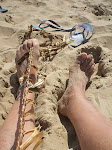 |
| La petite galerie du chateau du Roussillon |
Some months ago I was invited to participate in this exhibition which is currently on show until the 30
th October in the Chateau de Roussillon in the Rhone Valley, south of Lyon. The idea behind the event was to pair up potters with basket makers in order for them to collaborate on some pieces. It is an interesting and popular idea, the
Scottish Basketmakers' Circle have a similar exhibition opening shortly at the
Collins Gallery in
Glasgow. Initially my collaborator was to be a potter in my region but that fell through, (I think it was the prospect of working with me) and I was then paired up with Michel Gardelle – a highly respected ceramicist who lives close to Mont de Marsan in the Landes region, some four hours south of where I live. Various things intervened and in the end we never met! With time running out we arranged that I would collect three of Michel’s pots from a friend of his closer to me and I was given carte blanche to do whatever I wanted with them.
 |
| Michel Gardelle's ceramic pieces |
This presented me with problems, not only because I find ceramic objects a bit scary ( I was terrified of dropping them) but also because here were three finished pieces that I really had no desire to do anything to! It would have been totally different if they had been created with a view to me working on them but these were not new pieces and had been conceived without that idea in prospect. In some way, therefore, it seemed disrespectful to add anything to them as Michel had already decided that they were finished pieces. This bothered me until I stood the three pieces on the studio floor in the sunshine. The shadows were each different and I immediately realised that I was going to make ‘shadow’ baskets.
 |
| Pots, shadows and baskets |
Once the idea arrived the work went quickly and I enjoyed making the three pieces. Each one taking inspiration from details on the pots as well as the shape of the shadows. I would not have made them without having had the opportunity to live with and look at Michels’ pieces in my studio, so for me, at least, the ‘collaboration’ was ultimately creative.
Last weekend we drove to
Roussillon to deliver the work. There I met Francoise Demoulins who is a basket maker and friend of Monica Guilera in
Catalonia. It was Monica who had suggested me as a possible participant in this event and I am grateful to them both. There were six exhibitors, the others were potters Sylvie and Francois Fresnais who were paired with the perigourdin expert Philippe Guerinel, and Christine Fabre who was paired with the irrepressible
Erik Barray, self styled Vannier Urbain. Neither Philippe nor Michel were there for the vernissage but it was a great pleasure to meet the others and for me a particular pleasure to meet Erik.
 |
Sylvie and Francois Fresnais
and Philipe Guerinel |
 |
| Christine Fabre and Eric Barray |
Nathalie and Jean-Jacques Dubernard, who live and work in a 200 year old pottery that is known as ‘La Poterie des Chals, were our hosts. They have changed very little at the pottery preparing their own clay and using foot powered wheels to make decorated slipware using only mineral glazes. The ancient wood fired kilns are impressive. They have a small shop and sell their work at many of the pottery fairs held in France. We could not have had better hosts.
The idea for the exhibition was theirs and the Association FIGLINAE that organised it came into existence because of their enthusiasm for their craft. Most of the forty members of the Association supported the opening by bringing food to share. The
vernissage was packed and fortuitously a bar next door was having a re-opening party after a change of management. The
Champagne flowed, the band played and the assembled potters, basket makers and friends took to the floor. Jean Jacques turned out to be the partner of choice for the women with his astonishing Ceroc moves; he will forever be ‘twinkle toes’ in my memory. Later back at the pottery the other JJ, aka ‘twinkle fingers’ played international folk tunes on his melodeon
. I am not sure whether the French audience understood “Aunty Mary had a Canary”, but the clapping and stamping implied they enjoyed it. I don’t think I have ever been to a better opening!




















